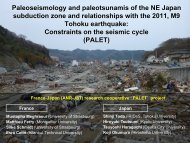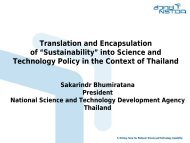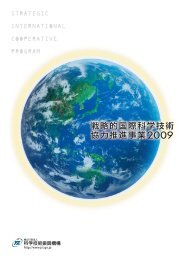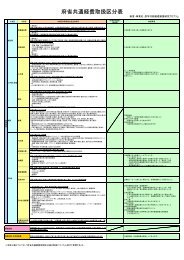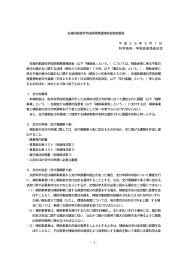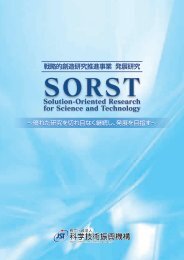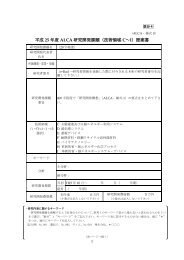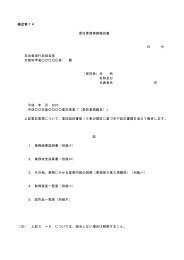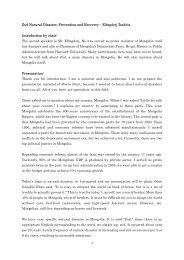jst highlights 2010 [pdf]
jst highlights 2010 [pdf]
jst highlights 2010 [pdf]
You also want an ePaper? Increase the reach of your titles
YUMPU automatically turns print PDFs into web optimized ePapers that Google loves.
Focus 02<br />
International “Dream Teams” Drive the<br />
Emergence of Research Hubs<br />
Centers of excellence<br />
draw leading domestic and<br />
overseas researchers<br />
JST programs support the creation of regional research hubs<br />
to attract leading researchers from Japan and overseas. In this<br />
article, we profile two such hubs—Nagano and Yamagata—<br />
where “dream teams” are at the forefront of research in key<br />
emerging-technology fields.<br />
Stories of scientific endeavor often contain many of the classical<br />
elements of history-making drama—world-renowned experts in<br />
a particular field gather together in a bid to make the next great<br />
breakthrough that will reverberate around the world. An unexpected<br />
twist in these stories is their setting. Rather than Tokyo, Osaka or<br />
Kyoto, hubs are being created in smaller cities where academia and<br />
industry can evolve and flourish symbiotically with backup from<br />
regional government and JST. This university-centered research<br />
hub concept encourages each region to focus resources on a specific<br />
field. Where there is strong potential for commercialization of new<br />
technologies, researchers who achieve the most outstanding results<br />
are invited to join a strategic “dream team.” This tiered system aims<br />
to foster the most advanced research possible while accelerating<br />
the R&D cycle. Both Nagano and Yamagata are striving to become<br />
internationally synonymous with key emerging-technology fields.<br />
Yamagata / Yamagata University<br />
Nagano / Shinshu University<br />
Osaka<br />
Tokyo<br />
Research Hub Example 01<br />
Shinshu University ⇔ Nagano Prefecture<br />
Exotic Nanocarbons:<br />
Synthesis and Application<br />
Professor Morinobu Endo<br />
Faculty of Engineering<br />
Director of the Institute of<br />
Carbon Science and Technology (ICST)<br />
Shinshu University<br />
•Obtained his PhD in 1975 from the University of Orleans,<br />
France, and was a visiting researcher at CNRS.<br />
•Co-author of the paper “Filamentous Growth of Carbon<br />
through Benzene Decomposition” (Journal of Crystal Growth,<br />
Vol. 32, 1976). This was the first report of chemical vapor<br />
deposition (CVD) growth of nanometer-scale carbon fibers.<br />
At Shinshu University in Nagano Prefecture, researchers are<br />
exploring practical applications for exotic nanocarbons,<br />
or ENCs, thereby pushing beyond the boundaries of<br />
existing carbon nanostructured materials. Nanocarbons are<br />
fabricated by minutely controlling the structure and form of<br />
carbon at the nanometer scale in order to obtain novel functions<br />
and advanced properties that are not present in conventional<br />
forms of carbon. By deliberately introducing heteroatoms or ions,<br />
ENCs offer the potential of even more innovative properties. The<br />
integration of heterogeneous elements enables the synthesis of new<br />
materials whose basic structure remains carbon but which are,<br />
in fact, quite unlike carbon. In the near future, ENCs are likely to<br />
play important roles in critical fields—from the environment and<br />
energy to IT and medicine.<br />
Leveraging “harmony in diversity” to generate bold ideas<br />
In Japan, there is an ancient proverb that says, “Strive for harmony,<br />
not uniformity.” It tells us to value teamwork while respecting<br />
individuality. Professor Morinobu Endo, leader of the ENCs project,<br />
sees this as the spirit from which bold ideas are born. The need for a<br />
research environment based on this philosophy was the driving force<br />
behind the creation of the ENCs research team.<br />
Professor Endo comments, “If one looks at research teams in the<br />
United States, naturally there are many researchers from the Americas<br />
and Europe, but there also many from India and China. Hence, one<br />
can observe the pursuit of research involving a high level of crosspollination<br />
and collaboration among members who bring a diverse<br />
array of cultural traits. For example, American culture tends to<br />
emphasize the pursuit of one’s dream, while India is renowned for the<br />
mathematical mind and China has a reputation for business acumen.<br />
No matter how much perspiration one expends, research efforts in<br />
Japan that utilize only homegrown talent are not going to generate<br />
the kind of multinational creativity one finds overseas. Inevitably, the<br />
similarity in the team members’ backgrounds leads to a similarity in<br />
thinking, making a breakthrough much harder.”<br />
The concept behind the ENCs team is to build a “Nanocarbon<br />
Valley” cluster of excellence in Nagano Prefecture, which already<br />
boasts a high level of expertise in carbon-related research. There is an<br />
established network of companies in Nagano aiming to leverage the<br />
region’s strength in carbon materials. Combining this with Shinshu<br />
University’s laboratories and other research infrastructure will<br />
enable Nagano to stay at the leading edge of nanocarbon research<br />
internationally. However, the ENCs project is not simply about<br />
stimulating Nagano’s industrial base. Rather, the idea is far bolder, as<br />
Professor Endo explains, “Exotic nanocarbon research is about helping<br />
the planet—it’s about the future of humanity.”<br />
Future Applications<br />
ENCs: potentially useful in the electric<br />
double-layer capacitor (EDLC) and as<br />
an anode material or as an additive in<br />
lithium-ion battery systems, which are<br />
likely to be used in electric vehicles.<br />
Research Hub Example 02<br />
Yamagata University ⇔ Yamagata Prefecture<br />
Global Leaders<br />
in Organic Electronics<br />
Professor Junji Kido<br />
Graduate School of Science and Engineering<br />
Yamagata University<br />
Director of the Research Institute for<br />
Organic Electronics (RIOE)<br />
•Received his PhD in 1989 from Polytechnic University,<br />
NY, and was a research scientist at Brookhaven National<br />
Laboratory (1990−1992).<br />
•Co-author of the paper “Multilayer White Light-Emitting<br />
Organic Electroluminescent Device” (Science, Vol. 267, 1995).<br />
This paper reported a breakthrough in organic EL.<br />
At the Research Institute for Organic Electronics, established<br />
seven years ago in Yamagata Prefecture, Professor Junji<br />
Kido has been at the forefront of vigorous efforts to<br />
develop practical technologies that harness the potential of organic<br />
semiconductors in partnership with companies in Yamagata and<br />
beyond. Professor Kido’s research has been instrumental in the<br />
application of organic electroluminescence (EL) technology to the<br />
commercial production of organic EL display devices and lighting<br />
equipment. New commercial applications for organic EL are being<br />
rapidly developed by the private sector. To facilitate the development<br />
of applications for organic devices and accelerate the formation of a<br />
regional industry cluster focusing on organic electronics, Yamagata<br />
University has taken the lead by inviting top-class researchers from<br />
Japan and around the world to participate in basic and applied<br />
research. This program focuses not only on organic EL research but<br />
also aims to build an internationally recognized center of excellence<br />
in the field of organic electronics. As well as having a galvanizing<br />
effect on the university, this program has the objective of providing<br />
impetus to the regional economy and industry in Yamagata<br />
Prefecture. Ultimately, the participants envisage Yamagata as the<br />
world’s preeminent “Organic Electronics Valley.”<br />
Creating an attractive research hub for personnel and enterprises<br />
To attract top researchers, Yamagata <strong>highlights</strong> its existing strengths<br />
and future potential. The area has a large number of manufacturing<br />
firms with cutting-edge technical capabilities, while local<br />
government agencies proactively support the development of an<br />
organic electronics cluster. This infrastructure—transforming basic<br />
research output into commercial technologies—is a key advantage.<br />
It is often said that for researchers at the vanguard of scientific<br />
discovery, there are no prizes for runner-up. Thus, in an era of<br />
24/7 global competition, there is an enormous incentive to make<br />
a breakthrough and stay one step ahead of the pack. Professor<br />
Kido, too, is very conscious of the global picture. “By bringing<br />
together a team of top researchers, we are able to expand our scope<br />
from organic EL to the broader field of organic electronics while<br />
also accelerating the pace of R&D. I hope that this will contribute<br />
to shorter lead times from basic research to application of new<br />
technologies. We are targeting the creation of a self-sustaining cycle<br />
for organic electronics in Yamagata. Breakthroughs draw significant<br />
international attention, which enhances our access to the latest<br />
information. It draws talented people, research funding and dynamic<br />
business enterprises. These factors help propel further research<br />
advances. By maintaining the momentum of this positive cycle, we<br />
will bolster our standing as an international research hub.”<br />
Future Applications<br />
Organic EL: potential for mass<br />
production of lighting equipment and<br />
displays using a printing process. Thin<br />
and flexible materials may be used<br />
for displays and lighting. Potential<br />
for developing printed photovoltaic<br />
cells at lower cost than conventional<br />
amorphous silicon.<br />
<br />
JST HIGHLIGHTS


![jst highlights 2010 [pdf]](https://img.yumpu.com/23706752/6/500x640/jst-highlights-2010-pdf.jpg)
